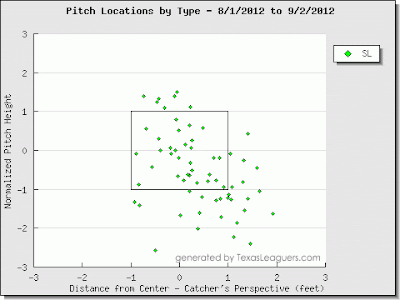(How does nobody get a shot of mini fist pump yesterday? Courtesy of the AP)
The Yankees stood pat at the trade deadline when it came to addressing their relief pitching needs. They had Joba Chamberlain close to coming back and were counting on his return to help fill the void created by the bullpen's regression. Looking back now, it's easy (and correct) to say that strategy was flawed. Putting faith in a player returning from a 14-month layoff that included Tommy John Surgery was misguided, and Joba's early results in his first 9 appearances reflect that. Any way you cut it, 9 ER and 22 total baserunners allowed in 7.2 innings pitched is rough. In this past week, however, we've seen signs that Joba is starting to find himself and starting to turn things around. His command in general has greatly improved, but his slider has been very sharp and has really been the driving force behind his resurgence.
Joba has made 3 appearances since his dreadful outing against Baltimore on September 2nd. In those 3 outings, he's pitched 4.1 innings and allowed just 1 run on 1 hit (a HR to Mark Reynolds) with an 8/1 K/BB ratio. Outside of the home run we're talking vintage Joba-type domination here, and small sample size or not that's noteworthy given how bad Joba's numbers had been prior. In those first 7.2 IP from August 1st to September 2nd, Joba threw 64 sliders. The pitch location chart for those sliders looks like this:
(Courtesy of Texas Leaguers)
That's a lot of misplaced sliders up in the zone and out over the plate, and the results generated on these pitches show that hitters were eating them up. Joba got a 62.5% swing rate on the slider, but just a 23.4% whiff rate and a 21.9% in-play rate. The hits and runs that Joba gave up in this timeframe indicate that hitters were doing damage on those balls they put in play, and looking at that chart it should come as no surprise. Most Major League hitters are going to punish hanging sliders that catch that much of the plate. Now let's look at Joba's slider location over his last 3 appearances:
(Courtesy of Texas Leaguers)
That's a much better looking chart. More balls down in the zone and around or off the outside corner to right-handers, which is where Joba's slider is most effective as an out pitch. The PITCHf/x numbers show that his slider has had more vertical and horizontal movement in his last 3 outings, creating that sweeping, dropping motion that makes the pitch difficult to square up, and the results speak to how much more effective the pitch has been. Out of 23 sliders thrown since 9/2, Joba has gotten a 52.2% swing rate on them, less than the month prior, but also a much better 39.1% whiff rate. 12 of the 23 sliders he's thrown have been swung at and 9 of those 12 swings have been misses. The movement that Joba is generating on his slider is the type of movement you want to generate those swings and misses as the ball drops out of the strike zone, and it's the type of movement he wasn't getting in August when the pitch was flatter and staying up in the zone.
His fastball command has also been improved in these last 3 outings, especially on the corners yesterday, and that has allowed him to better set up his slider as a swing-and-miss pitch. But a pitcher still has to hit his spot to make an out pitch effective and Joba has done a much better job of that with his slider this past week. Yes, we're dealing with really small sample sizes, but everything in this sample size indicates that Joba is starting to find his feel and command again, and the results he's generated both with the slider and in general support that theory as well. It's still too early to say Joba is "back," but if this is a sign of things to come, the Yankees might end up being vindicated in their decision to trust in Joba as a bullpen savior.



























No comments:
Post a Comment